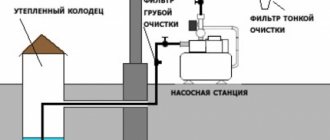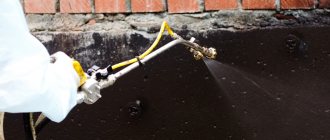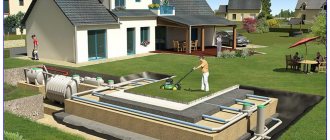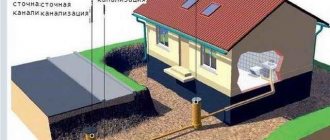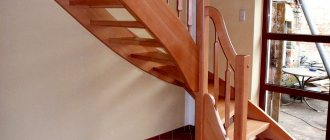Choosing pipes for laying in the ground
External sewerage pipes experience more severe loads than those located inside the building. In internal networks, pipes are laid along the walls; in extreme cases, sewerage pipes are laid under the floor. External sewerage pipes are laid in deep trenches, and they have to experience soil pressure.
Advice! If it is necessary to lay a sewerage pipeline under a road, it is necessary to use pipes of the highest strength class.
Sewer pipes for laying in trenches
A special type of pipes is produced for external networks. To prevent consumers from being confused with the choice, manufacturers paint such pipes brown-orange or red. While pipes intended for installation of internal sewage systems are usually dark gray.
The following types of pipes are used to assemble external sewerage:
- Smooth polymer - made of PVC or polypropylene.
- Corrugated polymer - made of polyethylene or polypropylene.
- Cast iron.
- Asbestos-cement.
It must be said that polymer pipes are most often used. Moreover, corrugated products are recommended to be used where the load is especially high - when deep installation is necessary or when placing a pipeline under a highway.
Advice! The most common pipe size used for the construction of external sewerage in a private house is 110 mm. In addition to pipes for assembling the pipeline, it is necessary to purchase shaped parts - bends, crosses, revisions, etc.
Factors
The depth of laying sewer pipes in a private house depends on the terrain and technical characteristics of the pipeline. Experts include the main ones:
- soil freezing level. Below this mark, the moisture present in the soil does not turn into ice;
- level of the entry point into the septic tank or collector;
- the strength of the pipes themselves;
- degree of load on the pipeline. Low load is recorded in the normal local area and on sidewalks. In the laying areas where vehicles move, there is an increased load.
Unlike the methodology for designing water supply communications, the calculation of the depth of laying sewer pipes in a private house is carried out not by adding a certain distance to the freezing depth, but by means of a subtraction operation.
The depth of the trench for sewer pipes must comply with the standards
For example, if sewer pipes with a diameter of up to 0.5 m are laid, 0.3 m is subtracted from the freezing depth. That is, when the level of conversion of moisture into ice is at around 1.30 m, the depth of sewer pipes in a private house will be equal to 1.30 -0.3=1 m. If a larger diameter pipeline is laid, 0.5 m should be subtracted.
Helpful advice! You cannot dig a ditch of less depth. In order to reduce the cost of excavation work, you can dig trenches as narrowly as possible, but you should not forget about the convenience of laying pipes.
Stages of laying external sewerage
Many people, thinking about installing sewerage into their home, wonder how to lay sewer pipes? The whole process can be divided into several stages:
- Drawing up a plan for the future sewer system and calculating all the necessary materials that will be needed to install the system. Here, not only the required length of pipes is taken into account, but also all the necessary corners, transitions and branches that may be needed are calculated.
- Carrying out all earthworks.
- Installation of the entire pipeline.
- Carrying out backfilling.
This instruction will help you lay a sewer system in a country house or cottage without any unpleasant surprises, since all possible cases have already been calculated at the planning stage, and thus you have nothing to fear.
The main types of autonomous sewerage for a country house
Despite the fact that many consider cesspools to be a thing of the past, this type of autonomous sewage system is the easiest to build with your own hands.
An equally important argument in defense of cesspools is the fact that their internal arrangement has now changed.
Before you make a sewer system in your house like a cesspool, you need to find out the engineering and geological features of your site.
The easiest way to build the walls of a cesspool is from brickwork, with red ceramic brick being the most acceptable option.
If it is possible to use additional equipment, then you can build a cesspool from reinforced concrete rings. Experts recommend concreting the bottom of the cesspool, covering the pit with a slab with ventilation and a special inspection hatch.
Septic tank made of polypropylene
Are you still undecided on how to make a sewer system in a private house yourself?
We recommend installing a local autonomous sewage system, for example, a septic tank.
This type of sewage system is especially relevant in those houses where people constantly live, and has gained particular popularity among Russians.
The septic tank is quite simple and reliable to use; it can be easily installed on your own by following the step-by-step installation guide (it is included when purchasing a septic tank, for example, their polypropylene).
In addition, septic tanks do not require frequent cleaning, so you will spend less money on calling a sewer truck.
Modern septic tanks are even three-chamber; they have a very high degree of purification of wastewater and domestic water thanks to elements of the aeration system and biofilters.
Sewerage in a private house video will help you decide which type of autonomous sewer system is most suitable for your home and site.
Sequence of actions during the construction of an individual sewer system
Before making a sewer system in the house, you need to decide on the initial steps:
Determine the area where the sewer well (cesspool or septic tank) will be located.
Important: the drainage well must be located below the level of the house. Determine where the sewer exits the house. Carefully inspect the exit point of the collector pipe. Please note that at this point all drains and used water from all plumbing fixtures in your home will accumulate (kitchen sink, toilet, bathtub, boiler). Inspection of the place where water enters from the entire house is necessary in order to to ensure that the collector is installed correctly (there should be no distortions or deviations). Only after a preliminary inspection has been carried out can a preliminary design for the sewer system of a private house be drawn up. Please note: the external sewer system is usually straight, the internal sewer system usually has many bends and angles. Therefore, when drawing up its project, it is very important to calculate all the dimensions of the pipes, their bends, and so on. Only after everything has been thought out and calculated can you begin to purchase the necessary materials. We begin the installation of external and internal sewerage systems.
Requirements
It is customary to work out the sewerage layout in a cottage at the design stage of a residential building. It is better to decide in advance on the location of all plumbing and pipes in the house. Direct installation of sewage pipelines with your own hands or with the involvement of plumbers is carried out after the construction of the walls, but before finishing.
Sewage wiring diagram in the house
In order for the indoor sewage system to work properly and without blockages, it is necessary:
The two main documents regulating the installation of sewerage pipelines in a private house and the discharge of wastewater into the village sewer network or septic tank are SNiPs 2.04.01-85 (SP 30.13330.2012) and 2.04.03-85 (SP 32.13330.2012). They describe all the nuances of designing and installing a system for discharging domestic wastewater from a cottage.
Carrying out internal sewerage
Recently, polypropylene pipes have become especially popular. They do not corrode, so their service life is much longer than pipes made of steel and cast iron.
And installing polypropylene pipes is not that difficult. However, you need to take into account this fact: how many sources of drainage are there in the house.
For those houses where many plumbing fixtures are installed, a pipe with a diameter of at least 100 mm will be required. Consider this fact: when leaving the washbasin, the pipe has a diameter of 50 mm, so you will have to join pipes of different diameters.
But today this is not a problem - there are special adapters. Therefore, you don’t have to worry about sealing the joints - it will be reliable.
It’s a good idea to check the quality of the gaskets: they should not be damaged. Then there will be no leaks at the joints.
Connecting plumbing fixtures
As a rule, the riser is equipped with an inspection (it is installed from the floor at a height of at least 1 m) and a special exhaust pipe (it is installed 0.7 m above the roof of the house).
Why is such a complex riser design needed?
Connecting a private home to a sewer system involves the formation of gases and an unpleasant odor.
If the riser is equipped with reliable ventilation, then this is a guarantee of ventilation of the entire sewer system in a private house.
Essentially, polluted air is forced out through the riser. And the people living in the house do not suffer at all from the unpleasant odor.
Important: insulate the riser if it is located in an unheated room. In order to connect the riser to the external sewer, you need to use a special outlet, its diameter should be smaller than the diameter of the pipe on the riser
Experts recommend installing the outlet to the riser along the movement of dirty water at an angle of 90 degrees or more. To connect the risers, two bends with an angle of 135 degrees are used.
In the case when another additional riser is required, then you need to use an oblique tee with an angle of 45 degrees and another additional outlet.
Therefore, it is much easier to connect to the sewer system of a private house yourself if there is one riser or one collector pipe.
For laying external sewerage, a polypropylene pipe with a diameter of 150 mm is best suited.
Sewer fittings
For those who still doubt their own abilities, we recommend watching: how to make a sewer system in a private house video. We hope that all your doubts will disappear and you will get to work with enthusiasm.
Factors that determine installation depth
When choosing the depth of pipe laying, it is necessary to take into account a number of factors that have a significant impact on this value and, accordingly, determine the cost of installation work.
- Purpose of the sewer network.
- Method of laying sewerage.
- Climatic conditions in the region.
- Possibility of additional load on the sewer pipe.
Let's look at these criteria in more detail.
Types of sewer networks
For most ordinary people, sewerage is associated only with the removal of sewage from residential premises, but in fact, the concept of sewerage is more extensive and includes various networks.
Storm drainage system
- A storm drainage device is designed to collect and drain atmospheric precipitation. The depth of the storm drainage system should not be less than the depth of soil freezing. When insulating the system, it is possible to reduce the depth to 0.7 meters.
- Cable ducting is designed to ensure the safety and possibility of replacing electrical lines. Laying electrical cables in special pipes greatly simplifies the installation process. The depth of the cable duct is determined mainly by the material of the pipes from which it is made. When using plastic pipes, it should be at least 0.4 m, and when using steel sewers - 0.2 meters.
The depth of laying a domestic sewer depends on a whole range of factors, which we will consider below.
Construction of an external sewer system
If the internal sewerage system of a private house is practically no different from the sewerage system in an apartment, then the scope of work in the first and second cases differs significantly.
There is much less work to do if the house already has an old sewer system. In this case, you just need to dismantle the old pipes and use the same sewer paths as before.
But it may happen that you have to completely redo everything. In this case, there is a lot of work ahead: you need to raise the floor (spread it) and if the depth of the sewerage outlet from the house is not sufficient, we deepen it.
To do this, we dig a hole under the foundation, then measure the distance from the bottom edge of the foundation to its top edge.
This distance should be 1 meter or more, then the drains in the collector pipe at the exit from the house will not freeze, even in the Russian winter.
From the outside of the house we also dig a trench to the drain well. Moreover, experts recommend digging a trench deeper on the street than inside the house, and ensuring its constant slope.
This measure is necessary to ensure the unimpeded flow of water and wastewater.
How to properly lay sewer pipes in a trench
A do-it-yourself sewerage system in a private house involves laying pipes both inside and outside the house. Let's take a closer look at laying external pipes.
Connection of sewer pipes
Experts recommend pouring a layer of regular sand (about 15-20 cm thick) onto the bottom of the trench. This measure will save sewer pipes, including those made of polypropylene, from excessive pressure.
On sand, the pipes will sag slightly and take a comfortable position. This will save them from excessive pressure from the buried soil.
An important issue when laying sewer pipes is their connection and sealing of joints.
An inspection is needed so that if the pipe becomes clogged, it can be cleaned. We advise you not to save on installing revisions; the money spent will pay off during the operation of the entire system.
It is advisable to install an inspection after every 4 m; it is advisable to close the pipe exit from the outside with a special plug.
Preparing for laying sewer pipes
It's no secret that any premises where people live or work must have a sewer system.
But if in multi-storey buildings the process of laying sewer pipes is handled by public utilities, then having a private house, a person will have to take care of laying the sewer himself.
In principle, laying a sewer system cannot be called an extremely complex process, but it is quite labor-intensive.
Of course, it is necessary to correctly calculate and purchase the necessary materials, as well as dig trenches for laying pipes.
But these are the simplest processes; it is much more difficult to lay pipes in trenches, since at this stage it is necessary to adhere to certain norms and standards.
To begin with, it is worth noting that today, when planning to lay a sewer system, it is best to give preference to smooth search pipes made of polyvinyl chloride or polypropylene.
The best solution would be to use PVC pipes
Sewage pipes for laying in the ground are orange; such pipes are characterized by increased strength, reliability and durability.
When choosing pipes, you must take into account the load level, namely the depth of the pipes and the presence of a roadway above them.
If the load on the sewer system is large, then it is better to give preference to double-layer corrugated plastic pipes.
For heavy loads, use corrugated pipes
As for the diameter of sewer pipes, all standards and regulations require the use of pipes with a diameter of 110 mm.
The maximum depth at which sewerage can be laid is three meters.
It is very important to remember that laying sewer pipes in a trench is carried out using shaped parts, namely bends, couplings, adapters, tees, and so on.
Features of pipe laying
- For an autonomous sewer system, pipes with a diameter of at least 110 mm are used.
- Plumbing equipment can be connected to the system with pipes having a diameter of 50 mm.
- The horizontal angle of adapters and bends should be 45 degrees.
- Slope the sewer pipe from the drain point to the septic tank. The slope per linear meter of pipe must be at least 2 cm.
- For sewerage passing through the site, inspection and inspection wells are installed.
- The sewer system pipeline is insulated if it is laid above the freezing level of the soil.
- Silicone or a special sealant is used to seal the connections.
- The sewerage system begins with a discharge point and ends with a treatment facility or wastewater receiver.
- To remove gas accumulations, the entire system is equipped with ventilation holes.
- To lay a cast iron pipe you need special equipment.
- Installation of the sewer pipe begins after marking the entire system on the site.
You can make a sewerage system yourself without the use of heavy equipment if you choose polymer or plastic pipes.
What factors determine the immersion depth of sewer pipes
It is customary to bury the sewer system in the ground for several reasons:
- the need to hide the pipes from the eyes of the residents of the house;
- the desire to free up space for planting plants or installing amenities;
- protection of the system from low temperatures.
The assembly of external sewerage is carried out along the bottom of the trench, the depth of which is determined by various factors:
- level of soil freezing in winter;
- presence of permafrost;
- depth of soil water;
- soil composition at the line laying site;
- system configuration and composition;
- size, volume and depth of immersion in the soil of a septic tank or cesspool.
laying external networks
There are many factors, so in practice, the depth of laying a sewer pipe is usually determined by the most significant of them. For example, in many regions of Russia, the soil freezes to 2.5 meters or more, which cannot be ignored when performing work. In addition, the composition of the system is an important factor. Usually it is a free-flow pipeline in which all waste flows naturally at low speed. This means that the possibility of liquids freezing is extremely high and appropriate measures must be taken.
Pipe laying
Removing the sewer pipe from the house
The pipe laying process can be divided into three stages:
- Excavation.
- Pipeline assembly.
- Backfilling.
Excavation work
Before laying sewer pipes, it is necessary to properly prepare the trenches. Rules for performing earthworks:
- Trenches can be dug by hand or using earth-moving equipment.
- The width of the trench should allow the installer to work with the pipe while at the bottom.
Advice! If the pipes have a diameter of 110 mm, then the width of the trench should be 60 cm.
External pipes laid in trenches
- It is more difficult to determine what is the optimal depth for laying sewer pipes. According to standards, it must exceed the depth of soil freezing in a given area by half a meter. But in practice this condition cannot always be met. If pipes are laid at a shallower depth, then care should be taken to insulate them.
- Trenches must be dug with a certain slope. As a rule, the project requires a slope of 2 cm per meter of pipeline.
- When digging trenches, they are made 10 cm deeper than the designed pipe laying depth. This depth will be used to create a shock-absorbing cushion.
- The bottom of the dug trench must be well compacted; if there are large boulders or frozen lumps of earth on it, then they will need to be removed, the resulting holes will need to be filled with earth and compacted there.
- Sand or fine gravel is poured into the bottom of the trenches. Compaction of the cushion along the entire length of the trench is not required. But in places where inspection wells are planned to be installed, the poured sand will need to be compacted at a distance of two meters in each direction from the well installation site.
- In those places where the pipe sockets will be located, pits are arranged.
Pipe laying and assembly
Laying external sewer pipes in trenches
Let's consider the basic rules for laying sewer pipes:
- The installation of the pipeline begins from the point where the pipe exits the foundation of the house.
- The pipes should be laid along the trench, and the pipe sockets should be directed in the direction opposite to the movement of the drains.
- We make pipe connections. To do this, you need to clean the bell well and make sure that the rubber O-ring is installed in it. The smooth end of the pipe, which will be inserted into the socket, is cleaned no less thoroughly. Make a preliminary measurement of how the pipe fits into the socket until it stops, placing a mark on the smooth pipe. To facilitate insertion of the pipe into the socket, silicone grease is applied to the smooth end. If there is no lubricant, you can use liquid soap or dishwashing liquid. The pipe is inserted into the socket, and in order to compensate for linear deformations of the pipeline, the pipe is not inserted all the way, but a centimeter gap is left (when inserting the pipes, they are oriented according to the previously set mark).
- If it is necessary to rotate the pipeline, you must use bends with an angle of 15 or 30. The use of bends with an angle of 90 degrees is prohibited.
- In addition, the technology for laying sewer pipes involves the installation of inspection wells. These devices are necessary to monitor the operation of the pipeline and carry out cleaning in case of blockage.
- If this is provided for by the project, then the pipes are insulated. For this purpose, it is recommended to use insulation based on foamed polyethylene.
Performing backfill
Preparing to fill pipes in trenches
- Once the pipeline has been assembled and the slope of the pipes has been checked again, backfilling can begin.
- It is recommended to fill the first 10-15 cm of the backfill height with sand. In this case, it is necessary to carefully compact the sand along the edges of the pipe, but compacting the backfill on the pipe itself is strictly prohibited.
- Next, the pipeline can be backfilled with ordinary soil, which was removed when digging trenches. You just need to make sure that there are no large stones in the ground.
The process of laying pipes in trenches is not a difficult job, but requires care and patience.
It is very important to follow the rules for preparing trenches and installing a pipeline; only in this case will the work done be effective
https://kanalizaciyam.ru
Laying external sewerage pipes
Restrictions on the location of sewerage facilities:
- from 5 m from the home;
- from 20 – 50 m from a source of clean water;
- from 10 m from the garden.
A private building is removed to:
- 8 m from filter wells;
- 25 m from filter fields;
- 50 m from aeration treatment equipment;
- 300 m from drainage systems.
The water pipes to the septic tank are insulated to prevent them from freezing in winter with a heat insulator and placed in asbestos-cement structures. External wiring is carried out by elements with a cross-section of 10 - 11 cm, whose slope is 2 cm by 2 m. It is desirable to lay components without turns or corners.
Scheme of sewerage supply to the house
As you know, there are three types of sewer network arrangement schemes, namely:
Scheme of sewerage supply to the house
- Centralized type, which involves connecting the outlet from the house to the general highway.
- An autonomous type without pumping, which involves connecting the house to a septic tank for collecting solid waste and subsequent installation of a drainage system for settled water. In this case, the soil of the site is responsible for filtering the discharged water.
- Autonomous type with pumping, involving the collection of wastewater in a large storage facility, released by periodic pumping out of settled water. Moreover, the pumping of such water should be carried out by a special company that provides sewage disposal services.
And all sewerage schemes require an original plan for laying and connecting sewerage to the house.
Sewage arrangement diagram
Thus, in the case of a centralized wastewater collection scheme, the laying of sewer pipes in the ground is carried out from the central outlet of the sewer pipe of the internal network to the entrance to the collector of the central network. Such a pipeline is laid in one line and is supplemented with inspection wells, where dampers and revisions are installed to facilitate system maintenance.
In the case of installing an autonomous system without pumping, the laying of external sewerage networks is carried out in one line from the outlet of the waste pipe to the entrance to the storage facility. The pipeline is equipped with revisions and dampers.
In the case of installing an autonomous system without pumping, the sewer pipe is pulled from the sewer outlet to the septic tank, from which the drainage pipes are diverted. This is the most labor-intensive option for eyeliner, but also the cheapest to maintain.
Laying sewer pipes in the ground: we equip and insulate external sewerage
Laying sewer systems in a private home does not require any complex skills, special tools or deep special knowledge. However, small errors during installation work can later lead to serious damage to the system.
The communications are subject to quite serious pressure from the soil layer; they are exposed to cold, moisture, etc. Therefore, it is necessary to ensure that the laying of sewer pipes in the ground is done correctly.
Unloading and storage of PVC sewer pipes
Installation of PVC sewer pipes begins with unloading the resulting pipes and fittings and organizing their careful storage. Any pipe after transportation must be checked for defects
Unloading of pipes, either manually or using machinery, must be carried out with great care to avoid damaging them.
When unloading, it is unacceptable to throw frozen PVC pipes onto the cold ground or floor. The pipe should never be thrown at all, although PVC pipe is quite flexible, if not handled correctly it can crack even in warm weather. Moreover, a crack may be invisible, but during operation of the pipeline, it can cause leaks.
What pipes can be used
The material and profile are selected in accordance with the existing design of the wastewater system.
Cast iron products remain relevant due to their low price and durability.
They are resistant to loads and temperature changes, but are susceptible to corrosion. Modern technologies create anti-corrosion coatings that increase the service life of the product. Cast iron pipes are heavy, so trenchless installation of a sewer system will require special equipment and support personnel to create an engineering structure. When performing external sewerage, cast iron products must be provided with thermal insulation.
In recent decades, plumbing products made from PVP and PVC have appeared, which are not inferior in their properties to metal ones. They are much lighter, so installation with such products is easier. When installing an internal system in a bathroom or toilet, it is better to use polyvinyl chloride pipes. Polyethylene and polypropylene pipes are more suitable for outdoor systems. The advantage of plastic ones is that they practically do not accumulate deposits.
Asbestos pipes are resistant to aggressive environments. In an aquatic environment, asbestos only becomes stronger over time. In addition, under the influence of water flow, overgrowth does not occur on the inner surface of the pipes. Installing an asbestos system is not difficult, but it is sensitive to mechanical stress. You need to be careful when transporting and installing them. Protection must be provided to prevent subsidence and fractures. Asbestos products are not recommended for use in sandy soil as they have low resistance to sand.
Types of sewer pipes and their features
When choosing pipes, you need to consider:
- the ability to cope well with its main task - drainage, to prevent small debris from clinging to the internal walls and accumulating, forming blockages;
- resistance to aggressive substances contained in wastewater and soil;
- strength that does not allow the pipes to deform under the weight of the soil laid on top of the pipeline.
Sewage pipes have their advantages and disadvantages, which vary depending on the material from which they are made:
| Pipe material | Advantages | Flaws |
| cast iron | durability, resistance to loads, temperature changes | heavy weight, difficulty in transportation and installation, roughness of the internal surface, high cost |
| steel | resistance to mechanical stress, smooth internal walls | instability to moisture, susceptibility to corrosion |
| asbestos cement | durability, lightness, low cost | instability to mechanical stress, roughness of the internal surface |
| polyethylene | low cost, ease of transportation and installation, durability, resistance to chemicals, smooth internal surface | withstandable temperature - up to 50 degrees, instability to ultraviolet radiation |
| polypropylene | withstandable temperature - up to 80 degrees | low rigidity, susceptibility to deformation under mechanical stress |
| polyvinyl chloride | variety of types and sizes, ease of transportation and installation, smooth inner surface, wear resistance | withstandable temperature – up to 40 degrees |
Pipes made of polymers, in addition, can be smooth-walled or corrugated: the former are cheaper, the latter are more durable and elastic.
There are also insulated pipes and pipes with a built-in heating cable - they are used when installing shallow sewers.
Pipe selection
Trench diagram for sewer pipe.
External sewer pipes, like water pipes, experience much more serious impacts and loads than those laid inside the building. In addition to its own, dynamic loads, water hammer, a pipeline laid outside also experiences a static external load - the pressure of soil masses. The values of these influences are especially critical in sections of the pipeline located under the roadway - roads, especially dirt roads.
Therefore, it is important to make the right choice of the type of pipes used for arranging the external pipeline
Today the following products are used as sewer pipes:
- smooth polymer pipes - polyvinyl chloride or polypropylene;
- polyethylene or polypropylene corrugated pipes;
- cast iron;
- asbestos-cement.
The first 2 varieties are the most technologically advanced, reliable, and easy to install. Although a cast iron pipeline is considered very reliable and durable, it has significant drawbacks, the main one being high cost.
Layout diagram of sewer polymer pipes.
In addition, cast iron pipe products have a significant mass, so the production of a pipeline with a diameter of more than 200 mm is very difficult and practically impossible without the use of special equipment - an installation crane (or a pipe-laying crane).
Asbestos-cement pipelines are used even less frequently today. The reason for this is the low manufacturability of installation work, the need for coupling joints and, most importantly, the low mechanical strength, high fragility of asbestos-cement products, and the low maintainability of a pipeline made from such pipes.
Laying external sewerage overview of process stages
The procedure for laying a sewer network of any type involves the sequential implementation of the following work plan:
Choosing sewer pipes for laying in the ground
Plastic sewer pipes
At this stage you need to select the diameter and length of the pipe. Everything is simple with the length - it is equal to the distance from the waste outlet to the inlet into the collector or septic tank. The diameter of the pipe is selected based on the expected volume of waste. However, in reality you will have to choose between 110 millimeters and 150 (160) millimeters. These are typical sizes of household sewer pipes. If you are planning to build an industrial highway, the diameter will start from 400 millimeters.
In addition, you need to choose the type of “pipe” material. This is usually polyvinyl chloride (smooth pipes) or polypropylene (corrugated pipes). PVC products are less durable, but will cost less than PP pipes.
Determining the slope of the sewer pipe
This slope guarantees the flow of liquid through the pipeline under the influence of gravitational forces. That is, the system will discharge wastewater in a non-pressure mode.
We carry out excavation work
The depth of the trench for the sewerage must correspond to the level of soil freezing. Otherwise, the system will freeze in the winter.
Laying sewer pipes in the ground
Therefore, the entrance to the sewer main (outlet from the waste pipe) is immersed in the ground to a depth of 1.2-1.5 meters. The outlet depth is determined based on a 2-centimeter slope (per linear meter of pipeline).
As a result, at this stage a trench is being dug, the bottom of which goes towards the catchment point at a slope. Moreover, the width of the trench is 50-100 millimeters. And its walls, after being deepened to a level of one meter, are strengthened with shields and struts. The selected soil is stored in a special area; it will be useful for filling the trench after installation of the pipeline.
Sewage well
Extended sections of the sewer main are equipped with wells, the walls of which are reinforced with concrete rings. The bottom of the well coincides with the depth of the trench or falls below this mark (the missing part of the soil can be added).
At the same stage, a pit is dug for a septic tank or waste storage bunker. The selected soil is removed from the site and disposed of. It won't be useful for filling. After all, the selected volume will be filled by the structure of the septic tank or bunker.
In addition, at the same stage you can start laying trenches for the drainage system of an autonomous sewer system.
Laying sewer pipes in a trench
Laying sewer pipes
The pipeline is installed in measured sections (4, 6 or 12 meters each), which are connected into a socket. Moreover, it is better to lay a layer of sand 10-15 centimeters thick at the bottom of the trench; it will save the line from possible ground vibrations caused by heaving deformation.
Laying is carried out with the sockets up, that is, the socket should be the first in the flow path, and the smooth end should be located at a slope. Therefore, the assembly is carried out from the drain pipe outlet towards the septic tank.
Having completed the assembly, the pipe is covered with coarse sand, after which the trench is filled with selected soil, leaving a bump on the surface that will “sag” next spring, after the soil has “settled”. The remaining soil is disposed of.
Commissioning
Before filling the trench, it would be a good idea to check the tightness of the joints and the throughput of the pipeline. To do this, you can wrap the bell sections with newspaper and pour several buckets of water into the toilet.
If there are no wet spots on the newspapers, the system functions without compromising the tightness of the pipeline. Well, the throughput can be assessed by comparing the volumes of “introduced” and “output” liquid. If the same bucket of water reaches the outlet, then there is no stagnation in the sewer system, and you will not have problems maintaining the system.
Basic provisions of sanitary norms and rules
In 1985, Sanitary Standards and Rules were approved, according to which sewer systems must be installed.
The same document contains recommendations regarding the nuances of installation work. In particular, it contains information regarding the depth of the pipeline and other important points.
The rules for laying sewer pipes indicate that their laying depth must be at least 30–50 centimeters from the soil freezing mark in each region - the calculation is carried out from the lowest point of the pipeline.
When work is carried out in areas with increased load on the soil surface (for example, under the roadway), the products should be laid deeper, sometimes at around 9 meters.
The document regulates how sewer pipes should be installed in trenches:
- In the place where it is planned to lay a sewer drain from a private household, it is imperative to compact the ground. This will prevent erosion of the engineering structure by groundwater during heavy precipitation.
- The laying of an external pipeline is considered to be correctly completed if a pipeline slope is created, which should be from 1 to 2 centimeters per linear meter. This requirement must be observed because there is no pressure pressure in domestic sewer structures.
The technology for laying sewer pipes in a trench provides that in your own home, in a place where the pipeline bends sharply, you need to equip a special well.
This allows you to make repair work easier and to replace a section of the highway that has become unusable in the shortest possible time.
There is also a rule regarding the laying of pipes for sewer structures in the ground. It states that a layer of sand at least 15 centimeters thick must be poured onto the bottom of the trench, which will ensure the stability of the system and its convenient operation.
A similar layer should be placed on top of the sewer line. The use of backfill will simplify access to the pipeline if repairs are necessary.
Experts also recommend installing inspection wells in areas where there are significant differences in the depth of pipe laying. If the length of the network is large, several of them should be installed, maintaining a gap of about 25 meters.
Selecting material for laying external sewerage
Before you begin installing a sewer system, you should select pipes that can withstand environmental influences, since the impact on them in the house is much less than on the street. Since the pipes are laid in deep trenches, they must accordingly withstand significant soil pressure, which makes it necessary to use stronger materials than for internal sewerage. Today, the store offers the following pipes for laying external sewerage:
- smooth pipes made of polypropylene or PVC;
- corrugated pipes made of PVC or polypropylene;
- asbestos pipes;
- cast iron pipes.
Smooth PVC pipes for external sewerage
To prevent buyers from getting confused about which pipes are intended for indoor and which for outdoor use, manufacturers paint them in different colors. Pipes intended for indoor use are dark gray in color, while outdoor pipes are painted red or brown-orange.
Today, as a rule, smooth and corrugated PVC pipes are used for sewerage. This is due to the fact that, firstly, they are much cheaper than others, and secondly, they are very easy to install without additional equipment.
